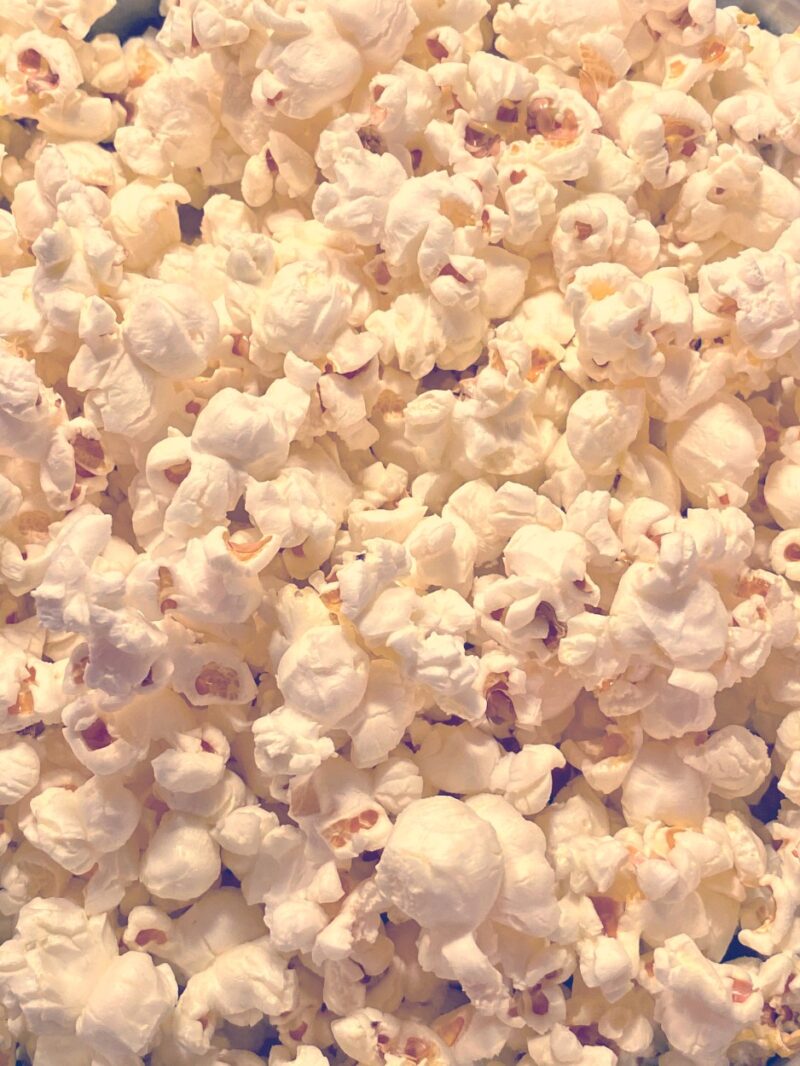“Years ago a friend told me how to butter toast. Start buttering from the sides, she said, because enough ends up in the middle anyway. I have not seen that friend in a quarter of a century. But she was right, and every time I butter toast from the sides I thank her in my head.”
– Joe Moran, First You Write a Sentence
There are, broadly speaking, two ways to pop corn: in the microwave or on the stove. The first method requires a bag of poppable corn—two, just in case—a bowl, and the ability to read instructions and press buttons. And wait, three to four minutes. Some listening and counting skills; stop when the time space between pops is longer than three seconds.
The latter method is outdated. The latter method is hard. It requires, first, a pot with a glass lid. This cannot be overstated. Then, excellent oil, ideally, from green olives pressed on a Sunday last September, in a Lebanese village on a mountain, then flown, triple, quadruple-wrapped, smuggled in a suitcase, to a homesick one-bedroom apartment housing four.
It requires heating the oil over a medium flame—medium, not high; olive oil burns; this method requires patience—with three kernels, no more or less, in the pot, spaced strategically. It requires stools or chairs or countertops and an audience’s excitement and attention.
Careful watching as the kernels fizzle and wiggle in the oil, through the glass lid, waiting, waiting… Pop! Pop! Pop! Then, swiftly and with style, opening the lid and pouring in the rest of the kernels. Then, the mastery:
Armed with a kitchen towel, grabbing the pot by both handles, lid firmly closed, and shaking! It requires a song and dance and the participation of every member of every age and nationality in the audience. Shake, shake! “La cucarachaa!” Then set the pot. The kernels equally coated with oil and spread across the bottom, a few more seconds’s patience… then the most spectacular popcorn fireworks.
Apparating, shooting up like rockets, stars, like … popcorn! Colliding, ricocheting on the glass surface just as heads retreat. Ratatating and rising and multiplying, threatening to burst to freedom. A pause. Deceptive. The mastery: another shake! Shake!
The popping resumes. The volume, again, is doubled. The audience, elated. The pot overflows. The children chase the escaped. This method then requires knowing exactly when to remove the pot, immediately salt and season and—one last shake—pour. Into far more than one bowl. The method takes years, twenty, of practice. The popcorn is perfect.
The Japanese notion of shokunin katagi translates, blandly and poorly, into “artisanal spirit.” It is a philosophy that runs wider and far deeper than skill. In Bunraku puppetry, for instance, which involves three men working a puppet half the size of a human, training lasts thirty years; the apprentice spends ten working the legs exclusively, then ten working the left arm, then the last decade on the right arm, the head, the eyes, the eyebrows, before becoming a master and showing his face to the audience. A sushi master will have spent years sharpening knives, sweeping floors, drying seaweed, massaging octopi, making rice over and over; a bonsai master whole seasons watering trees before touching a leaf. Shokunin katagi applies to calligraphy, raking gravel, arranging flowers, making bento boxes, brewing tea, potting, weaving, cleaning the Tokyo airport. It is the devotion to making “something for the joy of making it, quietly and beautifully.”
It is a social obligation, but a spiritual one first: “to infuse the quotidian with the pleasure of creation and the pursuit of perfection.” Pursuit, not attainment, makes life beautifully long, and days beautiful and short.
And in the evening, popcorn, with Lebanese olive oil, on the stove, just like twenty years ago. It was wonderful.
